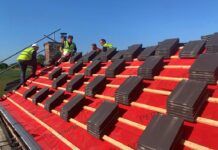Mark Dunn, head of training at Sika’s Roofing Division, underscores the critical importance of adhering to health and safety measures, especially in light of the Building Safety Act, and illustrates how compliance within the industry is effective for maintaining the Golden Thread of Information, emphasising the significance of comprehensive training by highlighting his company’s rooftop training programmes.
Working at height comes with a multitude of risks, which is why it is no surprise that the Health and Safety Executive (HSE) found that almost one in five deaths in construction work involve roof work, especially falling from roof edges or openings or through fragile rooflights. It is also important to remember that whether you are spending an entire day installing a roof, or just undertaking a survey that takes a few minutes, that you must still be trained to the same high-levels and aware of all the necessary precautions that must be taken. That is why it is vital for anyone working at height to be provided with the correct training, as well as ongoing support and guidance.
Government guidance
As a result of the tragic events at Grenfell, Dame Judith Hackitt carried out the Hackitt Review, and as a result devised the Building Safety Act (BSA) which was granted Royal Assent in April 2022. The Building Safety Act has added real transparency to building standards, meaning building owners are required to manage safety risks and take responsibility for safety during design, construction, completion and occupation of buildings.
The Golden Thread was created within the BSA as a way of making sure that anyone involved in a project has the right information in order to understand the building and the steps needed to keep both the building and anyone working on it, or using it, safe.
Additionally, those responsible for the building would need to show the completed building and any later work meets the requirements of relevant building regulations. Thanks to the Golden Thread, this information would be readily available.
Furthermore, the Golden Thread would help anyone involved in the project to identify, manage, understand and mitigate building safety risks throughout a building’s lifecycle.
With slips, trips and falls the biggest contributor to working at height accidents, the Golden Thread plays an essential role in improving the safety of anyone working on rooftops.
Effective roofing training from sika
Training and development is incredibly important to Sika, and its Roofing Division provides first-class rooftop training that spans a comprehensive amount of safety topics before offering all participants a practical session where they can learn to identify potential hazards and what they need to do to mitigate those risks.
Overseen by a knowledgeable instructor with over four decades of industry and working at height experience, the half day training course helps those carrying out roofing surveys recognise the hazards and risks associated with their day-to-day role and understand how to put control measures in place to minimise these risks. Once the course has been completed, a certificate of attendance is provided, endorsed by the Construction Industry Training Board (CTIB).
The courses are also approved by The Royal Society for the Prevention of Accidents (RoSPA), meaning they repeatedly meet a high set of standards for trainer competence and course quality. Sika empowers other companies to meet stringent safety standards by helping them receiving funding from RoSPA.
With the HSE going to great lengths to ensure all guidelines are followed and people go home safely to their families at the end of each working day, it’s important that while the industry as a whole puts huge importance on these guidelines, they must be filtered down to the end user by anyone in control of people working at height.
However, there is a misconception that training can be costly and difficult to source funding for, but fortunately this is not the case. The CITB offers a variety of funding opportunities, helping contractors access up to £100,000 to cover training costs. These funds cover everything from leadership and management development activities through to in-house training programmes and recognised external qualifications.
Despite advancements in safety measures, the risk of trips and falls remains a significant concern for those working at elevated heights. By investing in comprehensive training programmes, industry professionals can be equipped with the necessary knowledge and skills to foster a safer work environment for all.




